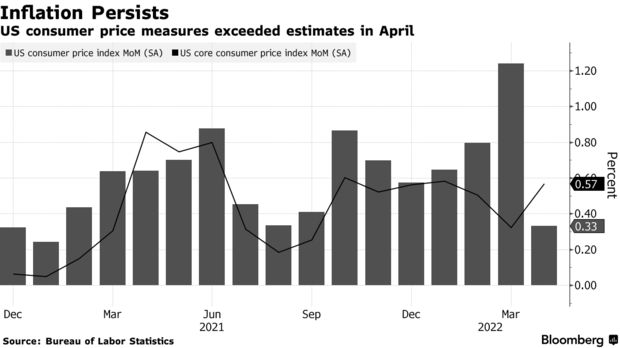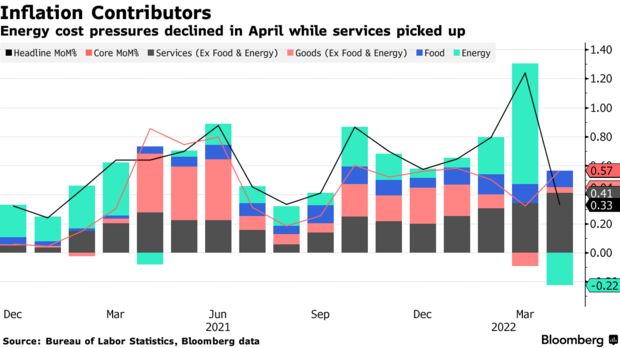US News
Prices in US Outstrip Forecasts in Sign of Inflation Persisting
US consumer prices rose by more than forecast in April, indicating inflation will persist at elevated levels for longer and keeping the Federal Reserve on the path of aggressive interest-rate hikes.
The core consumer price index, which excludes food and energy, increased 0.6% from a month earlier and 6.2% from April 2021, according to Labor Department data released Wednesday. The broader CPI rose 0.3% from the prior month and 8.3% on an annual basis, a slight cooling but still among the highest readings in decades.

Some of the largest contributors to the monthly increase included shelter, food, airfares and new vehicles.
The core CPI topped all estimates in a Bloomberg survey of economists, which had a median projection of 0.4%. The headline gauge was seen climbing 0.2%.
Buy Financial Times and The Economist Digital 3 Years Combo News Save 77% Off
Treasuries declined and the S&P 500 rose in early trading. Traders steepened bets for the path of Fed moves, increasingly betting on a fourth straight half-point rate hike in September.
“The peak of inflation may be behind us, but today’s CPI report points to a long, slow descent or maybe even a plateau around 8%,” said Robert Frick, corporate economist at Navy Federal Credit Union.
Breadth, Persistence H
While the latest report shows that US inflation has likely peaked, the figures underscore the breadth of price increases in the economy and, when combined with firm wage growth, suggest high inflation will persist for some time.
Despite the Fed raising interest rates, including the biggest rate hike since 2000 last week, global headwinds like China’s lockdowns and resilient services’ demand may mean a slow road to the central bank’s 2% goal.
Fed Chair Jerome Powell signaled last week that officials are open to several half-point increases in the central bank’s benchmark rate in the months ahead. The CPI will help shape estimates for the April personal consumption expenditures price index, the Fed’s preferred inflation gauge, which will be released on May 27.
Get Barron’s and The WSJ 5-Year Subscription $69, Save 77% Off
Inflation has put President Joe Biden and Democrats on their heels this year, threatening their thin congressional majorities despite a robust job market and resilient consumer spending.
A key expectation for a moderation in inflation this year hinges on slowdown in goods prices as Americans shift their discretionary income to activities like travel and dining out. The rate of goods and other commodities inflation declined while services costs increased by the most since 2001 on a monthly basis.

Food prices rose 0.9% in April, and were up 9.4% from a year earlier. The annual gain in food costs was the biggest since 1981 and included record advances in prices for chicken, fresh seafood, baby food and prepared salads.
Energy costs declined in April, as gasoline prices fell 6.1% from the prior month in what may prove to be just a temporary reprieve. Gas prices have since rebounded to a record high.
Shelter costs — which are the biggest services’ component and make up about a third of the overall index — rose 0.5% for a third straight month. Rent of primary residence climbed 0.6%, while owners’ equivalent rent increased by the most since 2006.
In another sign of soaring costs of household necessities, prices for energy services, which includes electricity and natural gas, were up 13.7% from a year earlier in the biggest advance since 2008.
Subscribe to The Telegraph UK Digital News 12 Months $55
Driven by a pickup in travel plans, the cost of hotel stays rose 1.7% while airfares surged a record 18.6% as airlines passed along higher fuel costs to consumers. New-vehicle prices advanced 1.1%, the most this year, while used-auto prices fell 0.4%.
Last week, Powell said “inflation is much too high” and emphasized the central bank understands the financial hardship for Americans.
Part of that hardship stems from the fact that inflation continues to erode even rapid wage gains. Adjusted for inflation, average hourly earnings fell 2.6% in April from a year earlier, marking the 13th straight decline, separate data showed Wednesday.
With Americans facing bigger bills for everything from groceries to gasoline, many have pinned blame on Biden. In a speech on the topic Tuesday, the president blamed the pandemic and Russia’s war in Ukraine.
“I know that families all across America are hurting because of inflation,” Biden said. With inflation near its fastest in generations — and nearly 60% of Americans disapproving of the president’s handling of the economy — Democrats face a difficult path to victory in the midterms later this year.
So-called base effects played a key part in Wednesday’s inflation report, with the year-over-year measures ebbing in April despite solid monthly advances. When calculating the year-over-year change in prices, the point of comparison was in 2021, when a surge in used-car prices pushed up the headline measure.

